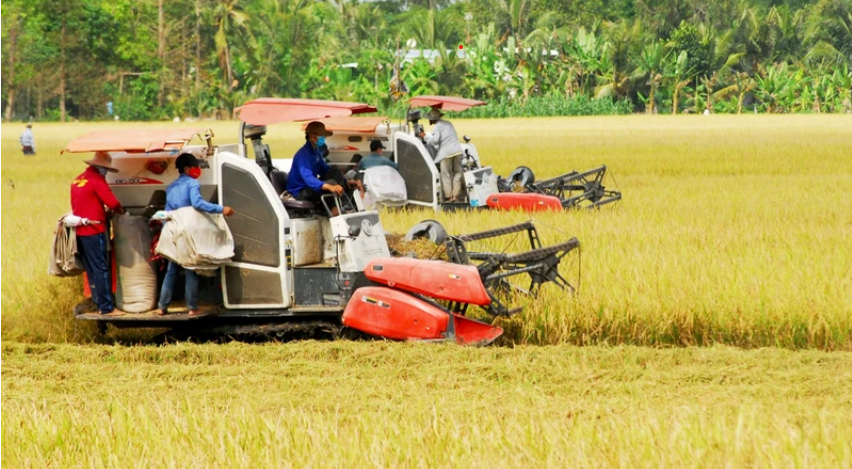On March 4, the Prime Minister issued Công điện số 21/CĐ-TTg regarding the management of rice supply and demand in response to global and domestic market developments. The goal is to promote sustainable rice production, trade, and export, enhance efficiency, increase farmers' income, seize export opportunities, and ensure a fair balance of benefits for producers and businesses.
Increasing Supply, Declining Demand
Mr. Nguyễn Văn Minh, a farmer from Bình Xuân Commune, Gò Công City (Tiền Giang Province), cultivated 0.6 hectares of OM 380 rice, yielding nearly 6 tons of fresh rice. However, he sold it at 5,100 VND/kg, which was 2,000 VND/kg lower than the previous season. Looking at his recently harvested field, he shared, "At the beginning of the season, traders placed deposits at 6,800 VND/kg, but by harvest time, the price dropped to 5,100 VND/kg. If we refused to sell, they would forfeit their deposit, so we had no choice but to accept the lower price."
According to the Tiền Giang Department of Agriculture and Environment, in the 2024-2025 winter-spring crop, the province cultivated over 42,200 hectares. So far, farmers have harvested about 30,000 hectares, with an average dry rice yield of 6.7 tons/ha, totaling nearly 200,000 tons.
Not only in Tiền Giang but across the Mekong Delta, farmers are rushing to complete the 2024-2025 winter-spring rice harvest. However, declining rice prices in most provinces have caused widespread concern among farmers.
As a rice trading enterprise, Mr. Huỳnh Văn Danh, Director of Vinh Hiển Co., Ltd., stated that rice prices have been falling sharply since before the 2025 Lunar New Year due to decreasing export prices and market difficulties. This has resulted in heavy losses for some milling and processing businesses, particularly those that bought rice at high prices earlier in the season but were forced to sell at lower prices later.
According to the Vietnam Food Association (VFA), Indonesia's domestic rice production is expected to reach 35 million tons by 2025, potentially eliminating the need for rice imports this year. These factors contributed to a global rice price drop in the first two months of 2025, with Thai rice prices declining by 10-11% and Vietnamese rice prices falling by 6%.
Close Monitoring and Timely Updates on Market Changes
In response to these new developments in the rice export market, the Prime Minister, in Directive No. 21/CĐ-TTg, instructed the Ministry of Agriculture and Environment to work with relevant agencies and localities to closely monitor the global rice market, particularly policy changes in major rice-exporting countries such as India and Thailand. Additionally, they must assess rice import demand in markets with growth potential, such as the United States, Japan, and Africa, and update information for businesses and local authorities to adjust production and export plans accordingly.
The Ministry of Industry and Trade has also been tasked with reviewing and revising Government Decrees No. 107/2018/NĐ-CP and No. 01/2025/NĐ-CP in the second quarter of 2025. These revisions will focus on establishing new criteria and conditions for rice trading and export businesses, prioritizing those with integrated supply chains, storage facilities, and modern logistics systems to prevent price manipulation by traders. Furthermore, the ministry will develop a credibility rating system for rice export and import businesses to streamline market operations and ensure transparency.
According to Mr. Ngô Hồng Phong, Director of the Department of Quality, Processing, and Market Development, the agricultural sector will continue to improve production structure and rice quality. The plan includes reducing low-yield rice acreage and focusing on high-quality rice varieties such as Jasmine, ST24, ST25, and other specialty rice. Additionally, efforts will be made to diversify rice-based products such as rice flour, noodles, and dried vermicelli, as well as to develop environmentally friendly rice brands to meet emerging consumer preferences.
Regarding consumption and export, collaboration between ministries is essential to promote trade and investment, particularly by expanding exports to large and emerging markets such as the U.S., EU, Japan, China, the Middle East, and Africa.
Financial Support for Rice Purchasing and Export
Financial support is a critical factor in rice procurement and export activities. The Prime Minister has instructed the Ministry of Finance to expedite tax refunds for rice exporters and directed the State Bank of Vietnam to assess the feasibility of expanding loan quotas and repayment periods for businesses with adequate storage facilities to stockpile rice during market downturns.
According to the Vietnam Food Association, improving access to capital and extending loan terms would allow businesses to hold inventory and sell at optimal prices rather than engaging in panic selling to cover losses or repay bank loans. This would help stabilize the domestic rice market and protect farmers' incomes from severe fluctuations.
